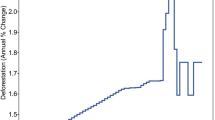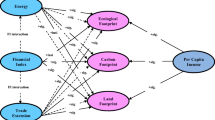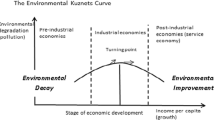Abstract
In addition to the adverse effect of extreme weather and weather variation across the globe, the ecological deficit accounting associated with the USA is perceived to have further worsen the country’s environmental quality. Considering the aforementioned motivation, this study examined the effects of cooling degree days, heating degree days and ecological footprint on environmental degradation in the USA over the period of 1960 to 2016. While employing the Autoregressive Distributed Lag (ARDL) and Bounds testing to cointegration approaches, the gross domestic product (GDP) per capita is further incorporated in the estimation model to avoid estimation bias thus enhancing a robust estimate. The result overwhelmingly found that the cooling degree days, the heating degree days and the ecological footprint accounting aggravates the country’s environmental degradation. Worse still, the study further presents that there is short-run adverse impacts of the heating and cooling degree days, and the short-run and long-run ecological footprint on the country’s environmental sustainability. Moreover, there is statistical evidence that the income growth in the USA especially in the long run will not also improve the environmental quality. Irrespective of the income-environmental degradation long-run relationship, the relieving impact of income growth on environmental degradation is observed in the short run. In general, the study presents relevant policy pathway for implementation.



Similar content being viewed by others
Notes
The cooling and heating degree days for the USA (from the aggregate of 48 states, available in https://www.epa.gov/climate-indicators/climate-change-indicators-heating-and-cooling-degree-days).
Dietz and Rosa (1994, 1997) had presented the determinants of carbon emissions in the framework of STIRPAT (Stochastic Impacts by Regression on Population, Affluence and Technology) model. However, Ehrlich and Holdren (1971) initially proposed the IPAT model to study the nexus of economic growth and environmental resources.
References
Adedoyin FF, Gumede MI, Bekun FV, Etokakpan MU, Balsalobre-lorente D (2020) Modelling coal rent, economic growth and CO2 emissions: does regulatory quality matter in BRICS economies? Sci Total Environ 710:136284
Alola AA (2019a) The trilemma of trade, monetary and immigration policies in the United States: accounting for environmental sustainability. Sci Total Environ 658:260–267
Alola AA (2019b) Carbon emissions and the trilemma of trade policy, migration policy and health care in the US. Carbon Manag 10(2):209–218
Alola AA, Alola UV (2018) Agricultural land usage and tourism impact on renewable energy consumption among coastline Mediterranean countries. Energy Environ 29(8):1438–1454
Alola AA, Kirikkaleli D (2019) The nexus of environmental quality with renewable consumption, immigration, and healthcare in the US: wavelet and gradual-shift causality approaches. Environ Sci Pollut Res 26(34):35208–35217
Alola AA, Bekun FV, Sarkodie SA (2019a) Dynamic impact of trade policy, economic growth, fertility rate, renewable and non-renewable energy consumption on ecological footprint in Europe. Sci Total Environ 685:702–709
Alola AA, Yalçiner K, Alola UV (2019b) Renewables, food (in) security, and inflation regimes in the coastline Mediterranean countries (CMCs): the environmental pros and cons. Environ Sci Pollut Res 26(33):34448–34458
Alola AA, Saint Akadiri S, Akadiri AC, Alola UV, Fatigun AS (2019c) Cooling and heating degree days in the US: the role of macroeconomic variables and its impact on environmental sustainability. Sci Total Environ 695:133832
Alola AA, Yalçiner K, Alola UV, Saint Akadiri S (2019d) The role of renewable energy, immigration and real income in environmental sustainability target. Evidence from Europe largest states. Sci Total Environ 674:307–315
Alola AA, Arikewuyo AO, Ozad B, Alola UV, Arikewuyo HO (2020) A drain or drench on biocapacity? Environmental account of fertility, marriage, and ICT in the USA and Canada. Environ Sci Pollut Res 27(4):4032–4043
Apergis N, Payne JE (2009) CO2 emissions, energy usage, and output in Central America. Energy Policy 37(8):3282–3286
Apergis N, Ozturk I (2015) Testing environmental Kuznets curve hypothesis in Asian countries. Ecol Indic 52:16–22
Bekun FV, Alola AA, Sarkodie SA (2019a) Toward a sustainable environment: Nexus between CO2 emissions, resource rent, renewable and nonrenewable energy in 16-EU countries. Sci Total Environ 657:1023–1029
Bekun FV, Emir F, Sarkodie SA (2019b) Another look at the relationship between energy consumption, carbon dioxide emissions, and economic growth in South Africa. Sci Total Environ 655:759–765
Ehrlich PR, Holdren JP (1971) Impact of population growth. Science 171(3977):1212–1217
Dickey DA, Fuller WA (1981) Likelihood ratio statistics for autoregressive time series with a unit root. Econometrica 49:1057–1072
Dietz T, Rosa EA (1997) Effects of population and affluence on CO2 emissions. Proc Natl Acad Sci 94(1):175–179
Dietz T, Rosa EA (1994) Rethinking the environmental impacts of population, affluence and technology. Hum Ecol Rev 1(2):277–300
Dogan E, Seker F, Bulbul S (2017) Investigating the impacts of energy consumption, real GDP, tourism and trade on CO2 emissions by accounting for cross-sectional dependence: a panel study of OECD countries. Curr Issue Tour 20(16):1701–1719
Global Footprint Network (2019). Ecological footprint. https://www.footprintnetwork.org/our-work/ecological-footprint/. (Accessed 2 January 2020)
Ike GN, Usman O, Alola AA, Sarkodie SA (2020) Environmental quality effects of income, energy prices and trade: the role of renewable energy consumption in G-7 countries. Sci Total Environ 721:137813
Isaac M, Van Vuuren DP (2009) Modeling global residential sector energy demand for heating and air conditioning in the context of climate change. Energy Policy 37(2):507–521
Işık C, Ongan S, Özdemir D (2019) Testing the EKC hypothesis for ten US states: an application of heterogeneous panel estimation method. Environ Sci Pollut Res 26(11):10846–10853
Joshua U, Bekun FV, Sarkodie SA (2020) New insight into the causal linkage between economic expansion, FDI, coal consumption, pollutant emissions and urbanization in South Africa. Environ Sci Pollut Res. https://doi.org/10.1007/s11356-020-08145-0
Kwiatkowski D, Phillips PC, Schmidt P, Shin Y (1992) Testing the null hypothesis of stationarity against the alternative of a unit root: how sure are we that economic time series have a unit root? J Econ 54(1–3):159–178
Li M, Cao J, Xiong M, Li J, Feng X, Meng F (2018) Different responses of cooling energy consumption in office buildings to climatic change in major climate zones of China. Energ Buildings 173:38–44
Moustris KP, Nastos PT, Bartzokas A, Larissi IK, Zacharia PT, Paliatsos AG (2015) Energy consumption based on heating/cooling degree days within the urban environment of Athens, Greece. Theor Appl Climatol 122(3–4):517–529
Mutlu Ozturk H, Dombayci OA, Caliskan H (2019) Life-cycle cost, cooling degree day, and carbon dioxide emission assessments of insulation of refrigerated warehouses industry in Turkey. J Environ Eng 145(10):04019062
Nathaniel SP, Iheonu CO (2019) Carbon dioxide abatement in Africa: the role of renewable and non-renewable energy consumption. Sci Total Environ 679:337–345
Nathaniel S, Anyanwu O, Shah M (2020) Renewable energy, urbanization, and ecological footprint in the Middle East and North Africa region. Environ Sci Pollut Res. https://doi.org/10.1007/s11356-020-08017-7
National Climatic Data Center (2019) What are heating and cooling degree days? National Weather Service. https//www.ncdc.noaa.gov.
Ozturk I, Acaravci A (2010) CO2 emissions, energy consumption and economic growth in Turkey. Renew Sust Energ Rev 14(9):3220–3225
Ozturk I, Al-Mulali U, Solarin SA (2019) The control of corruption and energy efficiency relationship: an empirical note. Environ Sci Pollut Res 26(17):17277–17283
Pesaran MH, Shin Y, Smith RJ (2001) Bounds testing approaches to the analysis of level relationships. J Appl Econ 16(3):289–326
Saint Akadiri S, Alola AA (2020) The role of partisan conflict in environmental sustainability targets of the United States. Environ Sci Pollut Res:1–10
Saint Akadiri S, Alola AA, Akadiri AC (2019a) The role of globalization, real income, tourism in environmental sustainability target. Evidence from Turkey. Sci Total Environ 687:423–432
Saint Akadiri S, Bekun FV, Sarkodie SA (2019b) Contemporaneous interaction between energy consumption, economic growth and environmental sustainability in South Africa: what drives what? Sci Total Environ 686:468–475
Saint Akadiri S, Alola AA, Akadiri AC, Alola UV (2019c) Renewable energy consumption in EU-28 countries: policy toward pollution mitigation and economic sustainability. Energy Policy 132:803–810
Saint Akadiri S, Alola AA, Olasehinde-Williams G, Etokakpan MU (2020) The role of electricity consumption, globalization and economic growth in carbon dioxide emissions and its implications for environmental sustainability targets. Sci Total Environ 708:134653
Shahbaz M, Solarin SA, Hammoudeh S, Shahzad SJH (2017) Bounds testing approach to analyzing the environment Kuznets curve hypothesis with structural beaks: the role of biomass energy consumption in the United States. Energy Econ 68:548–565
Solarin SA, Bello MO (2018) Persistence of policy shocks to an environmental degradation index: the case of ecological footprint in 128 developed and developing countries. Ecol Indic 89:35–44
Solarin SA, Bello MO (2020) Energy innovations and environmental sustainability in the US: the roles of immigration and economic expansion using a maximum likelihood method. Sci Total Environ 712:135594
United States Climate Alliance (2019). http://www.usclimatealliance.org/state-climate-energy-policies/ (Accessed 02 January 2020)
Udemba EN (2019) Triangular nexus between foreign direct investment, international tourism, and energy consumption in the Chinese economy: accounting for environmental quality. Environ Sci Pollut Res 26(24):24819–24830
Udemba EN, Güngör H, Bekun FV (2019) Environmental implication of offshore economic activities in Indonesia: a dual analyses of cointegration and causality. Environ Sci Pollut Res 26(31):32460–32475
Usman O, Iorember PT, Olanipekun IO (2019) Revisiting the environmental Kuznets curve (EKC) hypothesis in India: the effects of energy consumption and democracy. Environ Sci Pollut Res 26(13):13390–13400
Usman O, Olanipekun IO, Iorember PT, Abu-Goodman M (2020) Modelling environmental degradation in South Africa: the effects of energy consumption, democracy, and globalization using innovation accounting tests. Environ Sci Pollut Res 27:8334–8349
Wackernagel M, Lin D, Evans M, Hanscom L, Raven P (2019) Defying the footprint oracle: implications of country resource trends. Sustainability 11(7):2164
Author information
Authors and Affiliations
Corresponding author
Additional information
Responsible Editor: Nicholas Apergis
Publisher’s note
Springer Nature remains neutral with regard to jurisdictional claims in published maps and institutional affiliations.
Rights and permissions
About this article
Cite this article
Akadiri, S.S., Alola, A.A., Alola, U.V. et al. The role of ecological footprint and the changes in degree days on environmental sustainability in the USA. Environ Sci Pollut Res 27, 24929–24938 (2020). https://doi.org/10.1007/s11356-020-08884-0
Received:
Accepted:
Published:
Issue Date:
DOI: https://doi.org/10.1007/s11356-020-08884-0




